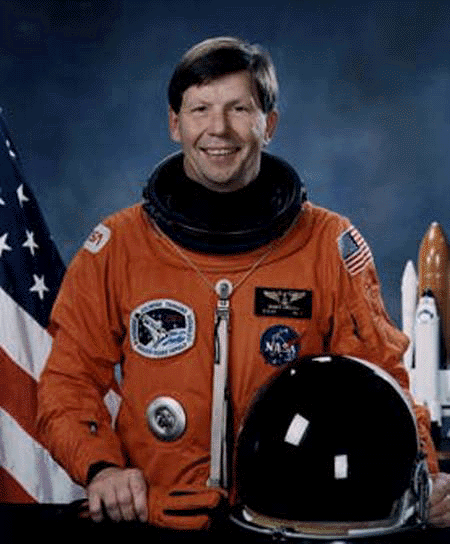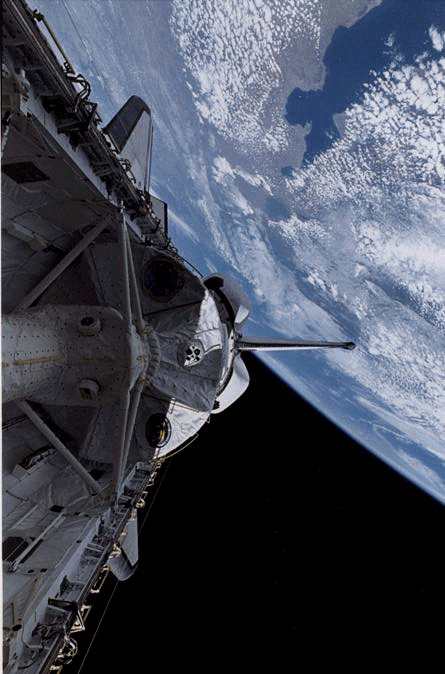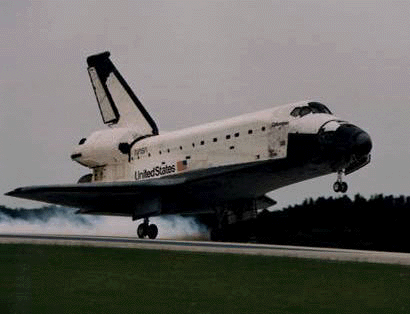
by Sally Harris
When the Space Shuttle Columbia achieves orbit March 27, 1997, Roger Crouch '68 and other crew members will open the air lock to the tunnel leading out of the shuttle's mid-deck, slough off their orange astronaut suits, "probably ooh and ahh" as they look out the window, then start activating the Spacelab.

At that moment, Crouch, who holds an M.S. and a Ph.D. in physics from Virginia Tech, will realize a dream that had been thwarted years ago by colorblindness: to be a fighter pilot or an astronaut. As the shuttle's free fall through space all but eliminates the force of gravity, Crouch and Gregory Linteris will serve as payload specialists, chosen by scientists to conduct the 25 or so experiments to be performed as the shuttle orbits the earth.
Crouch has been preparing for that moment most of his life. When he couldn't be a pilot, he pursued his goal of being a scientist. He chose to work in microgravity and materials science, including a year as a visiting scientist at MIT. Those skills led him into the space program.
NASA Langley's graduate-studies program in cooperation with Virginia Tech "allowed me to be where I am now," Crouch says. His advisor, physics professor Thomas Gilmer, helped Crouch find a topic in solid-state physics at Langley that would be acceptable in the Tech program.
Crouch eventually became leader of a NASA research group investigating the effects of convection on semiconductor crystals. He was a principal investigator in the NASA Microgravity Space and Applications Division (MSAD) flight program from 1977-1985.
As chief scientist of MSAD since 1985, Crouch had responsibility for assuring that the flight program's experiments in materials science, fluid physics, low-temperature microgravity physics, combustion science, and biotechnology achieved the highest levels of scientific results. After serving as program scientist on the ground for several Spacelab missions and co-principal investigator on an experiment that flew on one mission, he trained as the alternate payload specialist on the First International Microgravity Laboratory flight in 1992.
But for the March 1997 flight, Crouch, at last, will be on board doing the experiments while in orbit.
When Crouch is launched into space, some other Virginia Tech alumni will be watching closely, especially Eric Hammer (aerospace engineering '90) in Houston's mission-control center. Hammer will be the lead flight-dynamics officer in charge of the trajectory of the craft. "On this flight, a microgravity (low-gravity level) flight, the objective is to be as stable as possible, so we don't anticipate many maneuvers while they're up there," Hammer says. He will be predicting how the orbit will decay due to drag -- atmospheric forces that change the orbit. He also will make sure the predictions of the shuttle's abilities to reach the landing site are correct.
 Two of Crouch's fellow crew members will help Alan Moore (M.S. '83, Ph.D. exercise physiology '87) and Stuart Lee (exercise science and biology '87, M.S. exercise physiology '92) examine the ability to walk rapidly while wearing space suits after the flight. Working at Krug Life Sciences, a biomedical contractor to NASA, Moore and Lee do pre- and post-flight exercise testing and some in-flight monitoring of activities.
Two of Crouch's fellow crew members will help Alan Moore (M.S. '83, Ph.D. exercise physiology '87) and Stuart Lee (exercise science and biology '87, M.S. exercise physiology '92) examine the ability to walk rapidly while wearing space suits after the flight. Working at Krug Life Sciences, a biomedical contractor to NASA, Moore and Lee do pre- and post-flight exercise testing and some in-flight monitoring of activities.
"When a person is introduced to zero gravity, there's no force to work against, and the muscles become deconditioned," Moore says. "If they don't exercise, their cardiovascular system becomes deconditioned. Our job is to develop the proper exercises to prevent those things from happening."
Chris Edelen (aerospace engineering '89) will be one of the four flight-dynamics officers working with Hammer on Crouch's flight, and Greg Oliver (aerospace engineering '80) will be supervising the people working on the ascent and entry portions of the flight.
For Crouch, training for the mission started many months ago as he began traveling to principal investigators' labs for detailed instruction on the experiments chosen for the mission payload. At Marshall Space Flight Center (MSFC) in Huntsville, Ala., he trains on a mock-up of the Spacelab, complete with equipment. At the Johnson Space Center in Houston, he practices operations in specially outfitted space shuttle mock-ups and learns the operational capabilities of the shuttle on orbit as well as during launch and re-entry. Periodically, he will visit Cape Kennedy to see the actual shuttle and go through procedural reviews or go to the Lewis Research Center in Cleveland, Ohio, to train on hardware for the combustion and materials-science experiments.
Also, Crouch has conducted experiments on parabolic flights in a DC-9 aircraft that operates in a manner identical to the more famous KC-135 stationed at Johnson Space Center. The DC-9 climbs rapidly at a 45-degree angle (pull up), traces a parabola (push-over), and then descends at a 45-degree angle (pull out). Those in the plane experience twice the Earth's gravity during pull up and pull out, but near weightlessness during the top portion of the parabola, which lasts about 20 seconds. The plane goes in and out of the parabola several times per mission, causing gut-wrenching sensations that earned the plane the nickname "vomit comet."
"It takes the body a trip or two to get adapted to it," Crouch says. The mind has trouble switching gravity every 20 seconds, he says, and weightlessness causes the scientists to have to concentrate on holding themselves down while they do the experiments. Also, whereas on the ground a dropped test tube falls to the floor, in microgravity, it might float into someone else's face.
Once in orbit, Crouch and Linteris will perform the experiments while alternate payload specialists work in the ground control center at MSFC, linking the researchers there with their colleagues in orbit. The purpose of in-orbit experimentation is to study processes that are masked by the force of gravity on earth. Although the shuttle will be only 160 miles from Earth, it will be subject to only 5 percent of Earth's gravity.
Back on the ground, numerous Virginia Tech alumni, in addition to Crouch, Hammer, and Moore, have roles to play in various space missions other than Crouch's.
"My first day here I noticed a fellow in the next office who looked familiar," Moore says. "It was Dan Barineau, and we had taken a class together at Tech." Barineau (chemical engineering '87, M.S. '88) works for Lockheed Martin, a contractor to NASA, as a biomedical engineer developing a hardware program for the space station.
Brett Shifflett (mechanical engineering '88) and John Turner (aerospace engineering '84) also work with space projects, and at Krug, Lesley R. Lee (health and physical education M.S. '95) is a mission-support coordinator working the Human Life Sciences discipline of the US-Russian NASA-Mir Program. She coordinates all the preflight, inflight, and postflight training and data-collection requirements for U.S. medical studies on every other joint mission and has traveled to the Russians' Cosmonaut Training Center.
The exercise physiologist mentioned earlier, Stuart Lee, also has been to Russia to conduct training and testing with the cosmonauts, has been a subject in a variety of experiments, including simulated microgravity experiments aboard the KC-135 aircraft, and has worked with space crew members and watched them conduct the experiments from his group.
"We actually conduct tests on the crew members within hours of landing," he says. "This is one of the most satisfying times for us because we experience the end of the mission with the crew members and get our data at the same time."
The scientific investigations begun aboard STS-83 will yield results for some time after Crouch and his fellow crew members return to Earth at Kennedy Space Center April 11. But for now, the preparations and countdown continue slowly toward launch from Cape Kennedy March 27 and a dream come true for Crouch. "I've always had this goal in the back of my mind, and when I thought opportunity was knocking, I opened the door," Crouch says. "This time, it has turned out to be real."
Sally Harris is information coordinator for the College of Arts and Sciences.
Back to Features
Home | News | Features | Research | Philanthropy | President's Message | Athletics | Alumni | Classnotes | Editor's Page